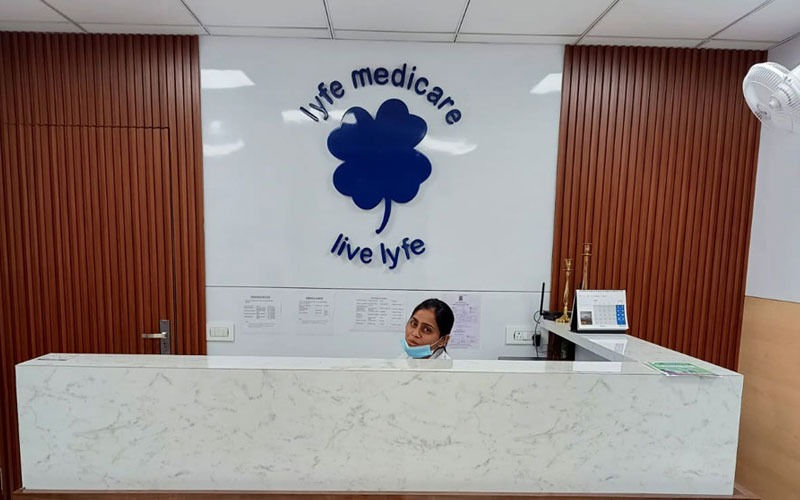How Many Chemotherapy Cycles Are There in a Cancer Treatment?
- lyfemedicarecancer
- Oct 11
- 4 min read
When an individual has been diagnosed with cancer, one of the most popular treatments that doctors may prescribe is chemotherapy in Delhi. Chemotherapy, or simply “chemo,” involves potent drugs that can destroy cancer cells. But a question many patients and families ask is:-
“How many cycles of chemotherapy will I receive?”
The reaction is not 100 per cent. In this article, we shall describe in easy terms what chemotherapy cycles are, how they are scheduled, and what determines how many cycles a patient may need.

What is a Chemotherapy Cycle?
Chemotherapy is not typically administered all at once. Instead, it is administered in cycles or phases. A chemotherapy cycle is when you are treated with chemotherapy medications and then rest.
For instance, the patient will undergo chemotherapy for 1 or 2 days and rest for 2 or 3 weeks. This resting period gives the body—particularly the healthy cells—the time to recover from the drugs’ treatment effects prior to the next cycle of chemotherapy.
A brief example:
Day 1: Take chemotherapy
Days 2-21: Rest phase (no chemo)
Repeat for several cycles
This course of treatment may span several months, depending on the stage and type of cancer.
How Many Chemotherapy Cycles Are Most Often Given?
4 to 8 is the usual number of chemotherapy cycles for most patients. The figure is not a standard number. The amount of cycles that are administered will vary on some considerations:-
Types of Cancer:
The various cancers utilize different treatment timelines. For instance:-
Breast cancer: Normally receives 4 to 6 cycles.
Lung cancer: Can receive 4 to 6 cycles depending on the seriousness and stage.
Lymphoma or leukaemia: Can get lots of cycles, maybe 8 to 12 or even more.
Colon cancer: Normally 6 to 8 cycles.
Different cancers react to chemo in varying ways, so doctors respond accordingly.
Stage of Cancer:
Early-stage cancers can require fewer cycles, whereas advanced or metastatic cancer (cancer that has spread to other organs) can be treated for extended periods.
Purpose of Treatment:
Two primary objectives of chemotherapy are:-
To attempt to kill cancer totally and cure the patient (curative).
To treat cancer, shrink tumours, and relieve symptoms where cure cannot be achieved (palliative).
Type of Drugs Used:
Some of the drugs used in chemotherapy are extremely strong and require more rest time. Others are mild and can be administered more frequently. The quantity and combination of drugs determine how long the cycles last and how many they require.
Patient’s Overall Health:
A patient’s age, kidney or liver function, blood counts, and other medical conditions also determine how many cycles are safe or indicated. If the patient is not tolerating treatment, doctors may decrease the number of cycles or alter the plan.
How is the Effectiveness of Chemo Monitored?
While chemotherapy is being done, physicians watch for the effect of the cancer with:-
MRI, CT, PET scans to assess tumour size
Blood tests to assess cancer markers
Bone marrow tests in blood malignancies
Physical examinations to assess symptom relief
If the cancer is responding or manageable, the number of ongoing cycles can be continued. In any other case, the pattern of treatment can be changed.
Can the Number of Chemotherapy Cycles be changed Midway?
Yes, chemotherapy schedules are flexible. Physicians can:-
Increase cycles if cancer is doing well and additional treatment would be beneficial
Reduce or stop early if side effects are too severe
Change drugs or add chemo to radiation or surgery if necessary
Follow-ups and lab results enable the oncologist to make these decisions. Patients are never over-treated with chemotherapy in Delhi.
What Happens After Chemotherapy Ends?
After the number of planned cycles is done:-
Most patients have scanning or blood tests to determine the last response
Follow-up plan is planned (every 3-6 months for the first few years)
Long-term side effects are treated
Emotional and nutritional rehabilitation is provided
In some cases, maintenance chemotherapy (low-dose drugs) is provided after the initial cycles, particularly in cancer types such as leukaemia or ovarian cancer.
Common Side Effects During Chemotherapy Cycles:
Every cycle of chemo will result in side effects. They include:-
Weakness
Loss of hair
Nausea and vomiting
Decreased white blood cell count (infection risk)
Sores in the mouth
Loss of appetite
However, not all the aforementioned effects are found in every patient and most of them are controllable by available drugs and supportive therapy.
Advice to Patients Receiving Chemotherapy Cycles:
Stick to your routine seriously – Don’t miss a dose without your doctor’s awareness.
Eat healthy food – A healthy body boosts recuperation time between cycles.
Drink lots of water – Water is what washes the chemotherapy drugs out.
Report early if symptoms arise – Call your doctor if you’re ill or have a fever.
Take rest seriously – Rest day is as essential as drug day.
Stay emotionally supported – Discuss with friends, relatives, or a counsellor.
Conclusion:
No specific answer exists to “how many chemotherapy cycles are required” because everyone is different. It depends on the type of cancer, stage, treatment objectives, patient health, and body sensitivity to treatment.
The difference is that the chemotherapy is administered by a trained oncologist who tailors the treatment regimen and tweaks it as necessary to achieve the optimum outcome.
If you and your loved one are going to start with chemotherapy in Delhi, be truthful with your doctor. Ask the doctor questions regarding the amount of cycles that have been recommended and why. Having the map in front of you relaxes you less and prepares you.



Comments